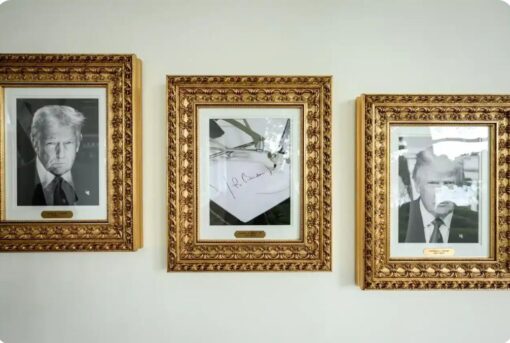Donald Trump has once again found a way to spark controversy inside the White House. His newest addition to the presidential residence, a so-called “Presidential Walk of Fame,” is lined with portraits of America’s past leaders stretching from George Washington to Barack Obama.
Yet one striking omission has captured attention around the world: there is no portrait of Joe Biden. Instead, Trump chose to hang a photograph of an autopen machine signing Biden’s name, a move that has already reignited his campaign to discredit the man he never accepted as a legitimate president.
The gallery runs along the colonnade leading to the West Wing and was unveiled this week as Trump hosted a dinner for allies and donors. While portraits of former presidents were displayed with traditional respect, Biden’s absence immediately stood out.
The replacement of his image with a photo of a mechanical pen was not subtle, but rather a calculated gesture. It reflects Trump’s repeated claim that Biden was unfit to lead during the final years of his presidency and that decisions were effectively made by aides rather than the man elected in 2020.

Trump has long promoted the idea that the autopen, a device used by presidents from both parties for decades to reproduce signatures, symbolized Biden’s incapacity.
Throughout his rallies and speeches, Trump frequently pointed to examples of Biden’s signed documents as evidence that the Democrat was not truly governing. He has accused officials in the previous administration of signing pardons, executive orders, and even foreign agreements without Biden’s full involvement.
None of these claims have been proven, and past presidents, including Republicans, have relied on the autopen without controversy. Yet Trump has managed to transform a routine bureaucratic practice into a weapon in his ongoing feud with his predecessor.
The symbolism of the White House gallery addition is powerful. In American tradition, portraits of presidents are more than decorations — they are acknowledgments of the nation’s continuity. By denying Biden a place among his peers, Trump is effectively erasing him from the line of American leadership within the most symbolic building in the country.
For Trump’s supporters, the display is an affirmation of their belief that Biden’s term was fraudulent. For opponents, it is another example of Trump rewriting history for political gain.
Political analysts were quick to interpret the installation as part of Trump’s broader strategy. Earlier this week at the United Nations, he openly mocked Biden before an audience of more than 100 world leaders, suggesting that the Democrat was never truly in control of his administration.
His refusal to acknowledge Biden’s 2020 victory has persisted into his second presidency, and now the autopen portrait cements that defiance into the architecture of the White House itself.
The act goes beyond personal insult, hinting at an effort to shape the way future visitors and historians perceive the Biden era.
The decision also reflects Trump’s obsession with aesthetics and symbolism. Since returning to office, he has overseen a series of dramatic renovations.
Gold trim has been added to the Oval Office walls, the Rose Garden has been replaced with stone paving, and massive flagpoles now tower above the lawns. Construction crews are currently at work on a grand new ballroom designed for large-scale state dinners and political events.
Within this context, the “Walk of Fame” is less about tradition than it is about crafting a narrative that aligns with Trump’s political brand — a narrative where rivals are diminished and Trump himself is elevated as the central figure.
Social media lit up quickly after images of the gallery appeared online. Trump loyalists praised the move as bold and humorous, arguing that the autopen photo captured what they viewed as Biden’s “absent leadership.”
Critics, meanwhile, condemned the act as petty and disrespectful, another example of Trump tearing down democratic norms for personal vendettas.
Some commentators warned that this was not simply a matter of décor but a dangerous rewriting of history, undermining the principle that every elected president deserves recognition regardless of partisan disputes.
Despite the uproar, Trump shows no sign of retreat. His aides have hinted that the gallery is only the beginning of a broader reimagining of presidential symbolism at the White House.
By choosing who is remembered and how, Trump is embedding his political message into the very walls of the nation’s most iconic home. Whether future administrations will reverse these changes or preserve them as historical curiosities remains uncertain.
What is clear is that Trump has once again turned the ceremonial into the political. The autopen portrait of Joe Biden is not merely an insult; it is a calculated display of power, a reminder of Trump’s refusal to yield even in matters of tradition.
In replacing a predecessor’s portrait with a machine, he has reduced the memory of Biden’s presidency to an object of mockery while simultaneously elevating his own role as curator of America’s political story. For supporters, the stunt reinforces loyalty. For critics, it is yet another warning sign of a leader determined to bend institutions to his will.

The “Walk of Fame” may have been presented as a celebration of presidential history, but in reality it is a statement about the present. Trump’s White House now bears his mark not only in policy but in symbols, architecture, and the stories told through the portraits that hang on its walls.
In those stories, Joe Biden’s place has been replaced by a machine, and with it, Trump has delivered a message to the nation and the world: in his view, history is his to edit.


